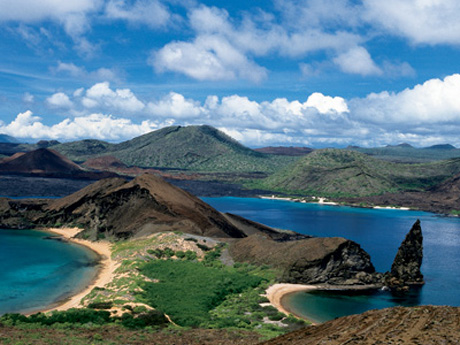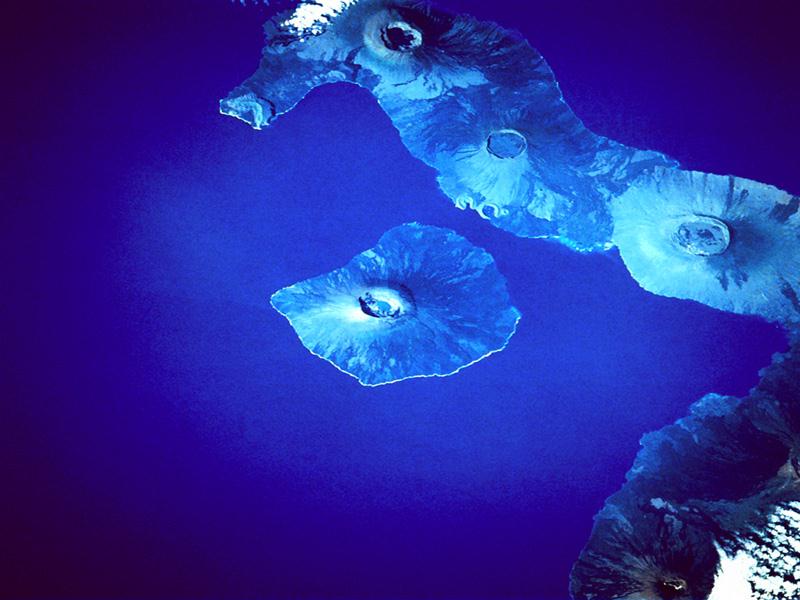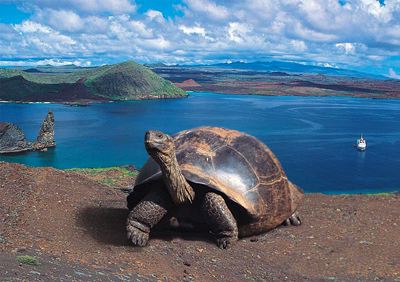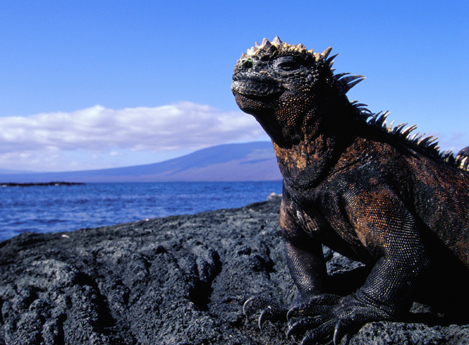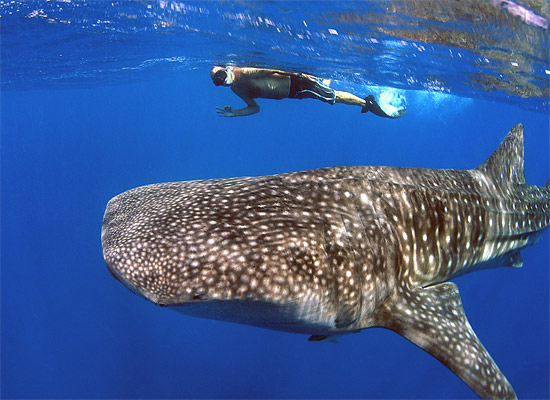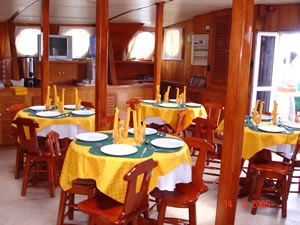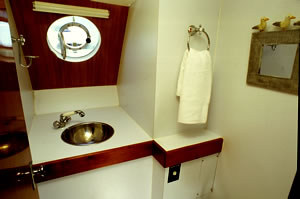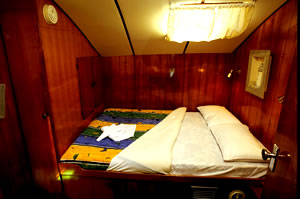Ecuador’s highlands are rich with Native culture and unsurpassed physical beauty. Beautiful vistas and traditional culture surround as we explore Ecuador's highlands. We travel the Avenue of Volcanoes and experience Otavalo and other Native markets, meeting traditional healers, llama herders and colorful native peoples in high mountain forests. While in Otavalo we are fortunate to visit during the incredible Inti Raymi ceremonies (Festival of the Sun), and we join local masked musicians and dancers. We explore by road, horseback and hiking with fantastic views in every direction. The Galapagos Islands are magic: the vast geologic differences between the islands and the magnificence of the amazing land and underwater life. Having literally risen from the sea, the Galapagos are in a position of near absolute isolation. Due to their isolation and protected status, animals have an almost total lack of fear from humans, which allow us inches close experiences. In 1979, UNESCO declared the Galapagos Islands a “Natural patrimony of Humanity” due to their incredible number of endemic species. They contain more distinct species of flora and fauna than any other place on earth. As a collection of volcanic island within a few hundred kilometers of the equator, the Galapagos provide incomparable landscapes and an exceptional climate. Known as the Archipelago of Colon, they lie in the Pacific Ocean 972 kilometers off the coast of Ecuador. The archipelago covers approximately 8.000 km2 and consists of six main islands, 12 smaller islands 42 islets, and countless small rock formations. Our private Galapagos cruise is on the S/C Nemo II, a first class sailing catamaran with capacity for 12 passengers accommodated in 6 double cabins, each one with private bathroom, hot water and air conditioned, and snorkeling equipment.
ITINERARY
JUNE 23 QUITO CAPITAL OF EQUADOR Depart USA and arrive to Quito with it’s many narrow cobblestone streets lined with whitewashed walls, classic plaza and ornate churches. Quito was founded in the 16th century on the ruins of an Inca city at 9200 ft., nestled into a valley in the shadow of the Pichincha Volcano. Its historic center is the largest in the Americas and ranks among the most beautiful. For this reason, UNESCO nominated it a World Heritage Site, the first city to receive the honor. We stay at the Hotel Patio Andaluz, the finest hotel in old town Ecuador (renovated this year), surrounded by churches, museums and national monuments. It was declared Cultural Patrimony of Humanity by UNESCO in 1978. The Hotel is now an official National Treasure and holds centuries of history within its walls. After Breakfast explore the bustling streets and squares of the largest historical center in the Americas, visiting some of its most important churches such as the impressive Cathedral, majestic La Compañía and iconic San Francisco, guardians of a stunning multi-ethnic artistic and cultural heritage. A fantastical explosion of gold throughout, especially the altars and pulpits, the church houses innumerable works of great religious art. We finish our visit to colonial history at the “Panecillo” hillside with its breathtaking views of the old and modern city surrounded by the rolling Andes Mountains. We eat lunch in the Pululahua crater. Overnight Quito, Hotel Patio Andaluz (B)
JUNE 24 COLONIAL CITY TOUR QUITO, MIDDLE OF THE WORLD After lunch, we visit the Middle of the World monument located at latitude 0º 0º 0º, and provides an opportunity to straddle both hemispheres. We also visit the Ethnographic Museum, which provides a fine overview of Ecuador’s varied peoples and geography. We travel overland past beautiful vistas to the colorful Otavaleños lake district, and to our lodging at Hacienda Pinsaquí. The Hacienda is ideally situated at the base of Imbabura Volcano, close to the lakes of San Pablo, Cuicocha and Mojanda, as well as the white colonial city of Ibarra and local handicraft villages like Cotacachi. The colonial hacienda was constructed in 1790, and following a disastrous earthquake that shook the region in 1867, faithfully and caringly restored. The building originally housed a textile workshop, employing nearly one thousand local weavers and spinners. During the 1800s, the hacienda hosted many important guests. Among these was Simón Bolívar, and the Treaty of Pinsaquí, signed in the hacienda on December 30th 1863, a chapter best forgotten in Ecuadorian history. The hacienda was undeniably built to impress. The furniture, including an exquisite chandelier and a behemoth writing desk, comes mainly from France and Spain. It was brought back by the free-wheeling and free-spending Freile of the early 20th century, who was rumored to have been a lover of Frida Kahlo while ambassador to Mexico. His experiences abroad influenced the decoration of the house. Throughout this hacienda mansion, you'll find yet more impressive chandeliers, acres of marble floors, framed newspaper clippings from the early 1800s and the wonderful aromas of fresh flowers and plants. Every lunch, local Indian musicians from Otavalo arrive to entertain listeners with their traditional music and warm characters, intimately sharing their culture, through verse and instruments, with the guests. Overnight Hacienda Pinsaquí (B,L,D)
JUNE 25 HIGHLANDS, LAKE DISTRICTS, INTI RAYMI FESTIVAL We visit San Antonio de Ibarra, renowned for its artisans who carve beautiful wood figures. We visit Ilumán, an indigenous community dedicated to felt hat production and famous for its traditional healers, curanderos and shamans. Finally, we head to Ibarra, the handsome colonial capital of Imbabura Province. Later we join masked musicians and dancers in the Plaza de Ponchos for the Inti Raymi festivities. Inti Raymi or Festival of the Sun is a Quichua ritual handed down from Inca times. Quichua culture is still very strong in Ecuador and specially in Otavalo. Overnight Hacienda Pinsaquí (B,L,D)
JUNE 26 HORSEBACK AVENUE OF VOLCANOES Morning hike around charming Cotacachi Village and Cuicocha (Guinea Pig) Lake, lying inside an old crater in the south side of the Cotacachi volcano, and afternoon explore from horseback to an interesting giant volcanic plug thrown from the Imbaburra Volcano. Overnight Hacienda Las Palmas (B,L,D)
JUNE 27 NATIVE MARKETS, OTAVALO Explore the colorful Otavalo Indian Market, the most spectacular in the Ecuadorian Andes from 4000 years ago and later visit sewing villages and learn about the indigenous weaving culture. Visit Peguche, a small town famous for its wonderful textiles, where we visit weavers at their looms and learn of their culture. Overland to Quito, Overnight Quito, Hotel Grand Mercure(B)
JUNE 28 GALAPAGOS THE GALAPAGOS ISLANDS Truly one of the great wonders of our planet. On our Galapagos cruise we sail mostly at night arriving to different islands by morning and anchoring in secluded coves. From white sand beaches to steep volcanic flows, we make several landfalls at each and explore by foot making incredibly close encounters with wildlife (within inches). Giant land tortoises, frigate birds, albatrosses, boobies, cormorants, etc.. Galapagos’ isolation and species protection has created virtually no fear from humans in the wildlife. One or two opportunities each day for spectacular snorkeling with sea lions, fur seals, penguins, turtles, dolphins, marine iguanas, green sea turtles, whales, sharks, rays and myriads of other marine life. We have the highest level Galapagos Guide during the cruise (Naturalist Level III) By using this small yacht we are able to explore some of the smaller less frequented islands and difficult to reach areas that the large boats cannot.
Fly to Galapagos, Baltra Island, Board Nemo II - Bachas Beach (B,L,D)
JUNE 29 GALAPAGOS
Morning land visit Bartholome Island and Sombrro Chino Island, Afternoon Cousins Rocks (B,L,D)
JUNE 30 GALAPAGOS
Morning breeding center in Isabela Island. Afternoon land visit to Tintoreras Lagoon (B,L,D)
JULY 1 GALAPAGOS
Morning Floreana Island, Post Office Bay. Afternoon Punta Cormorant, Enderby, Champion Rocks (B,L,D)
JULY 2 GALAPAGOS
Morning Española Island, land visit in Gardner Bay. Afternoon land visit Punta Suarez (B,L,D)
JULY 3 GALAPAGOS
Morning Santa Fe Island. Afternoon land visit to Charles Darwin Station. (B,L,D)
JULY 4 GALAPAGOS
Morning land visit South Plazas Island, Afternoon land visit North Seymour, Gordon Rocks (B,L,D)
JULY 5 GALAPAGOS, QUITO
Morning Caleta Tortuga - transfer to Baltra airport Fly to Quito, Overnight Quito Patio Andaluz (B, L)
JULY 6 DEPART QUITO
Flight home (B)
FOR MORE INFORMATION CLICK THE "CONTACT US" BUTTON OR:

BARRON
ADVENTURES
Adventures, Treks, Expeditions Worldwide
PHONE (562) 592 2050 FAX (562) 592 2099
BOX 100, SUNSET BEACH, CA, USA 90742
INFO@BARRONADVENTURES.COM
ISLAND INFO:
Bartolomé Island perhaps the best island to witness the geological forces at work with its eroded cinder cones, sharp pinnacles of rock, black lava flows, and solidified ash. We can take an easy hike to its 600-foot summit for outstanding views. Located off the eastern shore of Santiago Island a visit begins with a dry landing. Once ashore, the Summit Trail continues through volcanic sand, which can be slow to cross. Once through the sand the steep ascent continues up a wooden stairway. From landing to top the walk takes approximately 30 to 40 minutes. The volcanic landscape on the journey up seems barren except for the Lava Lizards scurrying about. Further up volcanic spatter cones with deep red, gleaming blacks and intense greens can be seen on both sides of the trail. The Spatter Cones and Lava Tubes give the feeling that you are hiking on the moon rather than an island in the Pacific. Arriving at the top you are treated to one of the great panoramic views in the Galapagos. To the distance the islands of Santiago, Santa Cruz, Baltra, North Seymour, Rabida as well as a number of rocks and small inlets can be seen. The islands vary in color from a bright orange, to blacks and greens. The turquoise waters and white shores add to the incredible seen. The eroded pinnacle rock stands at the end of the island poising for pictures. A short panga ride takes visitors to Bartolome's Double- Sided Beach. A short walk to the south beach leads through mangroves and past dune vegetation. Mating Sea Turtles are frequently seen as are white-tipped sharks, rays, blue herons. Returning to the north beach offers excellent swimming and snorkeling opportunities. Galapagos Penguins are frequently seen swimming in these waters.
Sombrero Chino Island is a tiny island just off the southeast tip of Santiago. Its name (Chinese Hat) describes the island's shape. Those visitors who travel to the island will find its special landscape worth the visit. Though centrally located it is one of the least visited sites in the area. National Park Service restrictions have limited the number of visitors to Sombrero Chino. Multi-day cruises with 12 passengers or less are the only ones permitted at this site. The landing is on a beautiful crescent-shaped white sand beach, home to Sea Lions and Sally Lightfoot Crabs. The trail on Sombrero Chino's explores its volcanic origin, one of the most evident in the islands. The lava rock is very fragile and tends to break off when people walk over it. The sharp outcroppings caused from these breaks make it necessary to bring good shoes. Patches of Pahoehoe Lava, cracked lava and lava tubes can be found on the island. While the path does not lead up the striking red rust sides of the Sombrero to the caldera, it does venture high enough on the island to offer some spectacular views of the waves crashing below. Snorkeling in the waters near Sombrero Chino can create a stir; white-tipped sharks frequent the area, as do the playful Galapagos Penguins and Sea Lions.
Isabela Island is made up of a series of volcanoes. At Tagus Cove we’ll have a chance to see the endemic flightless cormorant, only found in the western portion of the archipelago. We’ll also hike up into the dry zone above Darwin Lake, where we may see the woodpecker finch, one of the few tool-using birds in the world. Farther up the trail, there is a great vista, well worth the climb. There’s also time for a short panga ride to look for penguins and noddy terns. We sail along the southwestern coast of Isabela to look for whales and visit the mangrove lagoons of Elizabeth Bay and lower slopes of Volcan Alcedo at Urbina Bay, where land iguanas and giant tortoises forage. Shaped like a sea horse, Isabela is the largest of the the islands in the Galapagos, 80 miles in length and though it is remarkably beautiful it is not one of the most visited islands in the chain. Its visitor sites are far apart making them accessible only to faster boats or those with longer itineraries like ours. One of the youngest islands, Isabela is located on the western edge of the archipelago near the Galapagos Hot Spot. At approximately 1 million years old, the island was formed by the merger of 6 shield volcanoes - Alcedo, Cerro Azul, Darwin, Ecuador, Sierra Negra and Wolf. All of these volcanoes except Ecuador are still active making it one of the most volcanically active places on earth. Visitors cruising past Elizabeth Bay on the west coast can see evidence of this activity in the fumaroles rising from Volcan Chico on Sierra Negra. Two of the volcanoes Ecuador and Volcan Wolf lie directly on the Ecuador. Volcan Wolf is the youngest of Isabela's volcanoes and at 5,600 ft (1707 m) the highest point in the Galapagos. Isabela is known for its geology, providing visitors with excellent examples of the geologic occurrences that have created the Galapagos Islands including uplifts at Urvina Bay and the Bolivar Channel, Tuft cones at Tagus Cove, and Pulmace on Alcedo. Isabela is also interesting for its flora and fauna. The young island does not follow the vegetation zones of the other islands. The relatively new lava fields and surrounding soils have not developed the sufficient nutrients required to support the varied life zones found on other islands. Another obvious difference occurs on Volcan Wolf and Cerro Azul, these volcanoes loft above the cloud cover and are arid on top. Isabela's rich animal, bird, and marine life is beyond compare. Isabela is home to more wild tortoises than all the other islands. Isabela's large size and notable topography created barriers for the slow moving tortoises; apparently the creatures were unable to cross lava flows and other obstacles, causing several different sub-species of tortoise to develop. Today tortoises roam free in the calderas of Alcedo, Wolf, Cerro Azul, Darwin and Sierra Negra.
Floreana Island, we’ll walk to a fine white sand beach and along a lagoon, observing flamingos and other wading birds. Snorkeling is fantastic in and around Devil’s Crown, a half-submerged crater located just off the island where we see curtains of surgeonfish and Panamic sergeant majors, multihued parrotfish, sea turtles, and occasionally a shy hammerhead down deep. We’ll also visit Post Office Bay, where we can leave mail at the famous Post Office barrel and pick up mail to hand deliver as was the custom in the 1800s. One of the oldest islands Floreana illustrates the aging process of a volcanic island. Unlike the younger western islands, Floreana's volcano has been long extinct and is in the advanced stages of erosion. The erosion process gave the island the nutrients and soils need to sustain plant life. The combination of this rich soil and a good water supply have given the highlands of Floreana a diversified landscaping of native and introduced flora. Floreana is best known for its colorful history of buccaneers, whalers, convicts, and colonists. In 1793 British whalers established the Post Office Barrel to send letters to and from England. This tradition has continued over the years, and even today visitors may drop off and pick up letters, without stamps, to be carried to far destinations. Punta Cormorant offers two highly contrasting beaches. The landing beach is of volcanic origin and is composed of olivine crystals, giving it a greenish tinge. At the end of the short trail is a carbonate beach of extremely fine white sand. Formed by the erosion of coral skeletons, it is a nesting site for green sea turtles.
Española Island (Hood) has experienced more species isolation since it is upwind and upcurrent from the rest of the islands, thereby prohibiting island interchanges. Hood was also the first island to form and the first to be colonized from the mainland. As exploratory individuals left Hood to colonize other islands, the ones left on Hood evolved into unique species because of their isolation. For instance, lava lizards and mockingbirds are larger species than elsewhere, and Hood marine iguanas acquire bright red and green splotches during the breeding season. Waved albatross, with a wingspan of over seven feet, circle the cliffs endlessly. We’ll walk among a large rookery of blue-footed and Nazca boobies, waved albatross colony. Española's remote location helped make it a unique jewel with a large number of endemic creatures. Secluded from the other islands, wildlife on Española adapted to the island's environment and natural resources. Marine Iguana's on Española are the only ones that change color during breeding season. Normally Marine Iguanas are black in color, a camouflage, making it difficult for predators to differentiate between the Iguanas and the black lava rocks where they live. On Española adult Marine Iguanas are brightly colored with a reddish tint except during mating season when their color changes to more of a greenish shade. The hood mockingbird is also endemic to the island. These brazen birds have no fear of man and frequently land on visitors heads and shoulders searching for food. The hood mockingbird is slightly larger than other Mockingbirds found in the Galapagos; its beak is longer and has a more curved shape. The hood mockingbird is the only carnivorous one of the species feeding on a variety of insects, turtle hatchlings and sea lion placentas. Wildlife is the highlight of Española and the star of the show is the waved albatross. The island's steep cliffs serve as the perfect runways for these large birds which take off for their ocean feeding grounds near the mainland of Ecuador and Peru. Known as endemic to the island, Española is the waved albatross's only nesting place. Geographically Española is a classic example of a shield volcano, created from a single caldera in the center of the island. Over the years as the island has moved further away from the hot spot, the volcano became extinct and erosion began to occur. Española's two visitor sites offer an exceptional island visit. Gardner Bay is a favorite destination for swimming and snorkeling as well as offering a great beach. Punta Suarez is one of the highlights of the Galapagos Islands. The variety and quantity of wildlife assures a memorable visit. Visitors find migrant, resident, and endemic wildlife including brightly colored marine iguanas, Española lava lizards, hood mockingbirds, swallow tailed gulls, blue footed and masked boobies, Galapagos hawks, a selection of finch, and the waved albatross.
Santa Fe Island (Barrington) Santa Fe was formed from an uplift (rather than a volcano) giving the island a relatively flat surface rather than the typical conical shape of the other islands. Santa Fe is home to a number of endemic species including the Galapagos hawk, Galapagos snake, rice rats, a variety of finches and the Galapagos mockingbird. Visits to Santa Fe begin with a panga ride across the lovely turquoise lagoon. Once ashore you are brought into contact with of of the many sea lion colonies in the Galapagos. The loop trail around the islands leads past the salt bushes where Galapagos hawks can easily be approached. Hiking towards the cliffs leads you to a forest of prickly pear cactus. Santa Fe's trees are the largest in the Galapagos. Santa Fe is home to endemic Barrington Land Iguanas they have more pronounced spines along its back and is a lighter yellowish-orange than the iguanas . These iguanas are the largest in the islands and they are beige to chocolate brown in color and resemble small dinosaurs. Reaching the summit there is a stunning view of the cove beneath. Once back at the beach there is normally plenty of free time to snorkel back in the lagoon. Playful sea lion pups and florescent or visit a submerged rock where several manta rays and marine turtles can be found.
S/C Nemo II specs Galapagos First Class Touring Yacht
It's a large First Class sailing motor catamaran with a capacity for 14 passengers accommodated in 7 double cabins, each with private bathroom, hot water showers and air conditioned. Trans-oceanic Alumarine 72 ft. multihull yacht, for cruising and charters, designed by Lagenvin.
1 CQR anchor; Side stanchions with lifelines; Coast Guard safety package; Aluminum deck; Freshwater wash down system; Swim ladder; Bow pulpit with rails; Manual dinghy davits; Lofrans electric windlass; Fender & lines; 49 life jackets; life rings; Navigation lights; Single manually controlled search light; Swim platforms; Hull color is white.
Engine Room
Cockpit controls: hydraulic wheel steering, Thermal insulation, 3 bilge blowers, 3 exhauster bilges, 10 automatic and manual bilge pumps, 3 manual water pumps
Engine Details
Fresh water cooling system, Fuel filters, Hurth transmission/ratio 1 '1, Engine alarm, Engine and stove fuel shut off valves, Raw water sea strainers, Battery isolator, alternator, Racor filters, electrical shut off, 2 pump for oil services, Level bilge alarm.
New Electrical System
12 volt, 24 volt (DC); 220 volt, 110 volt (AC) Electrical System. 12 volt DC System Interrupter Selector, 2 battery Chargers, Promatic 50 amps 12 volts. Power-Mark 24 volt 6 amp., Kohler 12.5 Kw generator Transformer Acme 240-120 Power Inverter Vector Force 1,500w. 4 batteries 8D 1.300Amps/Hrs 12volts w/parallel switch. 24 Volts DC System 2 batteries 4D 1.000 Amps/Hrs 12 volts.,
Accommodations:
7 air-conditioned double cabins with en suite hot shower and toilet.
Main Saloon, with the vast cockpit and the unique exterior surface makes this beautiful catamaran, an exceptional cruising boat with amazing stability and exceptional service.
Electronics & Navigation:
16 mile Furuno Radar, Autohelm 600 Auto pilot; GPS; Depth Sounder, Speedometer, NEC boatphone and cellular phone, Wind Direction and Speed Indicator, VHF Radio, Compass, Stereo, TV & VCR
SCROLL DOWN FOR YACHT INFORMATION

Land Cost:
$5995 (10 persons)
Includes:
- USA and Local Ecuadorian guides
- All land based fees and permits (except Galapagos entry)
- All land transportation, buses, horses, etc.
- Galapagos guide during cruise (Naturalist level III, highest level)
- Meals as listed in the itinerary
Does not include:
- Galapagos entry fee: $100 per person, to be paid in cash upon
arrival at Galapagos airport
- Flight LAX-Quito-LAX: approx $550
- Flight Quito-Galapagos-Quito: $408
- Drinks
- Tips

